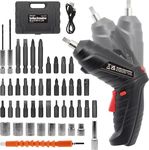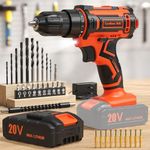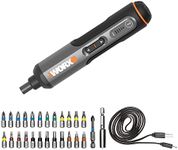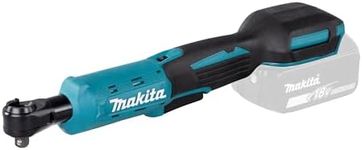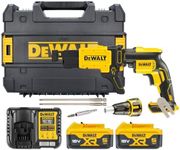Buying Guide for the Best Cordless Screwdrivers
When choosing a cordless screwdriver, it's important to consider how you plan to use it. Whether you're a DIY enthusiast or a professional, the right tool can make your tasks easier and more efficient. Consider the types of projects you'll be working on, the materials you'll be dealing with, and how often you'll use the screwdriver. This will help you determine the features and specifications that are most important for your needs.VoltageVoltage in a cordless screwdriver indicates the power of the tool. Higher voltage means more power, which is useful for tougher materials and more demanding tasks. Cordless screwdrivers typically range from 3.6V to 20V. For light tasks like assembling furniture or working with soft materials, a lower voltage (3.6V to 7.2V) is sufficient. For more intensive tasks, such as driving screws into hardwood or metal, a higher voltage (12V to 20V) is recommended. Choose based on the complexity and toughness of the tasks you plan to undertake.
Battery TypeThe battery type affects the performance and longevity of a cordless screwdriver. The most common types are Nickel-Cadmium (NiCd) and Lithium-Ion (Li-Ion). NiCd batteries are cheaper but heavier and have a memory effect, which can reduce their lifespan. Li-Ion batteries are lighter, have no memory effect, and hold a charge longer, making them more efficient for frequent use. If you need a screwdriver for regular use, a Li-Ion battery is preferable. For occasional use, a NiCd battery might suffice.
TorqueTorque is the force that the screwdriver can apply to turn a screw. Higher torque is necessary for driving screws into hard materials or for larger screws. Cordless screwdrivers usually have adjustable torque settings, allowing you to control the force applied. For delicate tasks, such as working with electronics or soft materials, lower torque settings are ideal to avoid damage. For construction or heavy-duty tasks, higher torque settings are necessary. Consider the materials and types of screws you'll be working with to determine the appropriate torque range.
SpeedSpeed in a cordless screwdriver is measured in rotations per minute (RPM). Higher speeds are useful for quickly driving screws, while lower speeds provide more control for precision tasks. Most cordless screwdrivers offer variable speed settings, allowing you to adjust the speed based on the task. For general household tasks, a speed range of 200-600 RPM is usually sufficient. For more specialized tasks, such as drilling or working with different materials, a wider speed range might be beneficial. Choose a screwdriver with speed settings that match the variety of tasks you plan to perform.
ErgonomicsErgonomics refers to how comfortable and easy the screwdriver is to use. A well-designed ergonomic handle can reduce fatigue and improve control, especially during extended use. Look for features like a comfortable grip, balanced weight, and easy-to-reach controls. If you plan to use the screwdriver for long periods or have specific comfort needs, prioritize models with superior ergonomic design. Testing the tool in your hand before purchasing can help ensure it feels right for you.
Additional FeaturesAdditional features can enhance the functionality and convenience of a cordless screwdriver. These may include LED lights for better visibility in dark areas, a quick-change chuck for easy bit swapping, or a built-in level for precise alignment. Consider which features will be most beneficial for your specific tasks. For example, if you often work in dimly lit spaces, an LED light can be very helpful. Evaluate the additional features based on your typical working conditions and personal preferences.


